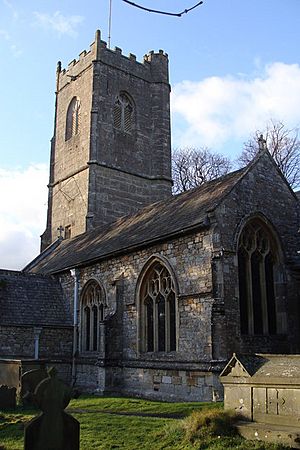St Tewdric's Church facts for kids
Quick facts for kids St Tewdric's Church |
|
|---|---|
| Church of St Tewdric | |
 |
|
| Denomination | Church in Wales |
| Previous denomination | Roman Catholic Church of England |
| History | |
| Status | active |
| Founder(s) | Meurig ap Tewdrig |
| Dedication | St Tewdric |
| Cult(s) present | King Tewdrig |
| Architecture | |
| Heritage designation | Grade I |
| Designated | 1955 |
| Years built | 6th century 13th century 15th century 19th century |
| Administration | |
| Parish | Mathern |
| Diocese | Diocese of Monmouth |
St Tewdric's Church is an old church in Mathern, Monmouthshire, Wales. It belongs to the Church in Wales. People believe it was built over the burial place of Saint Tewdric, a king from long ago.
A church has stood on this spot since the 6th century. Over time, it was rebuilt by the Normans and later updated by people in the Victorian period. Today, it is a Grade I listed building, which means it's a very important historic building.
Contents
The Church's Beginnings
Long ago, a book called the Liber Landavensis tells a story about King Tewdrig. He was hurt in a battle against the Anglo-Saxons near the River Wye. King Tewdric wanted to be buried on an island called Ynys Echni.
However, his soldiers could not get his body to the island. So, his son, Meurig ap Tewdrig, buried him in Mathern instead. A small chapel, called an oratory, was built over his grave. The land around it was given to the Celtic Christian Bishops of Llandaff. Later, Mathern Palace was built nearby for these bishops to use.
How the Church Changed Over Time
After the Norman conquest of Wales, the original Celtic church was rebuilt. This happened between the 12th and 13th centuries. The new church was built in the Early English style.
The main parts of the church, like the chancel (the area around the altar) and the nave (the main part where people sit), still show designs from the 13th century. Later, in the late 1400s, a bishop named John Marshall made the church much bigger. He widened the aisles, added a porch on the south side, and built the tall tower using smooth stone blocks.
Finding the Coffin and Victorian Updates
In 1614, a stone coffin was found. People thought it held the remains of King Tewdrig. At that time, a bishop named Francis Godwin moved the coffin to the chancel. An urn with the heart of another bishop, Miles Salley, was also found and reburied.
In the 1880s, the Church of England decided to update the church. John Prichard worked on some parts of the church. Later, Ewan Christian restored the chancel, rebuilt the south wall, and put on a new roof.
During these updates, the stone coffin was found again under the altar. Inside was a skeleton. The skull had a mark that looked like it came from an axe blow, which matched how King Tewdrig was said to have died. However, a historian named Fred Hando said an eyewitness claimed the skull only had a hole from a spear. The remains were buried again after this discovery. On a wall in the chancel, there is a sign from the late 1700s that says Tewdrig is buried there. It also mentions the coffin being found again in 1881.
Inside the Church Today
Today, you won't see any parts of the very first Celtic church. The oldest parts you can see are the arches in the nave and the arch over the chancel.
In 1943, the original medieval font (a basin used for baptisms) was found buried under the porch. It was then put back in the church for use. In 1955, the church was given its Grade I listed status. This was because it is a beautiful medieval church with interesting changes made by the Victorians. It also has an important history with the Bishops of Llandaff and their nearby Mathern Palace.
Images for kids







